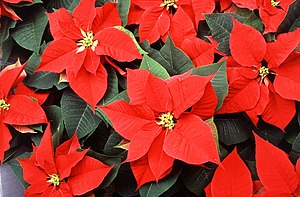Euphorbia pulcherrima
| Poinsettia | |
|---|---|
 | |
| Binomial: | Euphorbia pulcherrima |
| Genus: | Euphorbia |
| Family: | Euphorbiaceae |
| Height and spread: | 0.6 to 4 m (2 to 16 ft) |
Poinsettias (Euphorbia pulcherrima) are flowers native to southern Mexico, Central America, and Africa. They are named after Joel Roberts Poinsett, the first United States ambassador to Mexico, who introduced the plant in the U.S. in 1825. Alternative names for the poinsettia are Mexican flame leaf, Christmas star, Christmas flower, Winter rose, Noche Buena and Pascua.
In the U.S., poinsettias can be found in the wild in Hawaii and Puerto Rico.
Description
[edit | edit source]Poinsettias are shrubs to small trees, typically reaching a height of 0.6 to 4 m (2 to 16 ft). The plant bears dark green dentate leaves that measure 7 to 16 cm (3 to 6 inches) in length. The top leaves, known as bracts, are flaming red, pink, or white and are often mistaken as flowers. The actual flowers are the small yellow structures found in the center of each leaf bunch, which are called Cyathia.
Cultivars have been produced with orange, pale green, cream and marbled leaves. There are over 100 varieties of poinsettias available.
Growing conditions
[edit | edit source]In areas outside its natural environment it is commonly grown as an indoor plant where it prefers good morning sun then shade in the hotter part of the day. However they are widely grown and very popular in subtropical climates such as Sydney, Australia.
As this is a subtropical plant, it will likely perish if the nighttime temperature falls below 10° C (50° F) so is not suitable for planting in the ground in milder climates. Likewise daytime temperatures in excess of 21° C (70° F) tend to shorten the lifespan of the plant.
The Poinsettia can be difficult to induce to reflower after the initial display when purchased. The plant requires a period of uninterrupted long, dark nights for around two months in autumn in order to develop flowers. Incidental light at night during this time will hamper flower production. When watering it is important to allow the plant to drain out any excess water. Having a Poinsettia sit in water can do harm to the plant as it prefers moist soil to direct water.
Varieties
[edit | edit source]Uses
[edit | edit source]Its extract is useful for burn
Maintenance
[edit | edit source]- April 1: Reduce watering, 60 degrees F (15 Celsius)
- May: Cut back stems to 3-6 inches above the soil. Re-pot or separate if needed. Place in sunny window and water when soil is dry to touch. (Root cuttings if desired)
- June: Move plant outside. Water and fertilize more frequently as plant grows.
- July 1: First pinch.
- September 1: Bring plant indoors to sunny location at 65 degrees to 75 degrees F (18-23 Celsius).
- October: Initiate short days (for mid-December bloom date) Water as needed and fertilize weekly according to the label.
Thrives in room temperatures of 68 to 70 degrees F (15-21 Celsius). Do not put plants on top of a television or near fireplaces where the heat will be excessive. Also, avoid cold drafts and temperatures below 50 degrees F. Protect plants from chilling winds when transporting during the holidays.
Propagation
[edit | edit source]Harvesting
[edit | edit source]Pests and diseases
[edit | edit source]References
[edit | edit source]Cynthia Crossen, "Holiday's Ubiquitous Houseplant," Wall Street Journal, December 19, 2000.